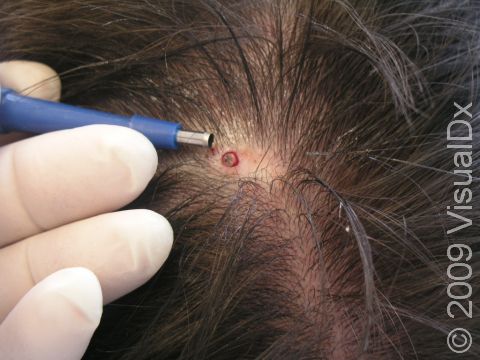Skin Biopsy
A skin biopsy is a common procedure in which a medical professional such as a dermatologist removes a small sample of skin for laboratory testing. It is typically done when the diagnosis of a growth or rash is in question after the physical examination, such as in the case of a suspicious mole that could be cancerous.
Two common types of skin biopsy include:
- Shave biopsy – A superficial skin biopsy where a thin layer is shaved off the surface of a lesion.
- Punch biopsy – A deeper, circular tissue sample is removed to examine layers of skin and stitches may be placed.
Once removed, the tissue sample is processed and examined by a pathologist. It usually takes up to a week and sometimes longer to get the results.
What to Expect During Your Visit
The medical professional performing the biopsy should ask about any allergies (eg, to local anesthetics) or medications (eg, blood thinners) you are taking. These questions help the medical professional anticipate and better manage potential complications.
Once the area of skin to be biopsied is cleansed with alcohol or antiseptic solution, a local anesthetic is injected in and around the skin area using a syringe topped with a very fine needle. The skin is then removed via a shave or punch biopsy and sent for examination under a microscope.
The medical professional will stop the bleeding, either with a hemostatic agent, such as aluminum chloride on a cotton-tipped swab (in the case of a shave biopsy), or stiches (in the case of a punch biopsy). Then, petroleum jelly (eg, Vaseline) and a small dressing will be placed over the wound.
What to Expect After Your Visit
Following the skin biopsy, you may have some minor oozing or bleeding. If so, apply a clean gauze pad to the area and place pressure on it for 5 to 10 minutes. There may be minor discomfort or pain after the local anesthetic wears off, but this is usually easily controlled with pain reliever such as acetaminophen (eg, Tylenol).
Following review of the skin biopsy results, your medical professional will share the results with you. Depending on the results, further treatment may be needed. Sometimes the skin biopsy is all that is needed, such as in the case of a suspicious mole where the mole was determined to be noncancerous. Your medical professional will work with you to determine what further treatment is needed, if any.
Typically, there will be a scar following skin biopsy. Sometimes a keloid forms, which is a thick, raised scar.
Follow-Up Care
Your medical professional will give you instructions for follow-up care at home, such as keeping the wound dry and covered for the first 24 hours and then gently cleaning the area, applying petroleum jelly, and putting on a new bandage every day until the wound heals.
Risks and Potential Side Effects
Skin biopsies are generally safe but can cause an allergic reaction, prolonged bleeding, scarring, infection, and bruising in the area.
When to Seek Medical Care
Contact your medical professional if you experience:
- Bleeding that does not stop.
- Pain that does not go away.
- Signs of infection, such as pain, spreading redness, pus formation, or fever.
- A wound that is not healing or is slow to heal (this is more common when the biopsy is done on the lower legs).
Trusted Links
References
Ludmann P. What is a skin biopsy?. AAD. https://www.aad.org/public/diseases/a-z/what-is-skin-biopsy. Updated 2022 Mar 4. Accessed 2024 May 3.
Olbricht S. Biopsy techniques and basic excisions. In: Bolognia JL, Schaffer JV, Cerroni L, eds. Dermatology. 4th ed. Philadelphia, PA: Elsevier; 2017:2478-94.
Last modified on June 24th, 2024 at 11:40 am

Not sure what to look for?
Try our new Rash and Skin Condition Finder
